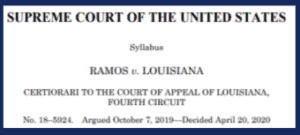In case you missed it amidst the distractions of 2020, the United States Supreme Court decided Ramos v. Louisiana in April of last year. I mention it now to underscore the importance of the recent Supreme Court decision in Edwards v. Vannoy.
In Ramos, the Court held that a defendant in a state criminal case has the right to a unanimous jury decision. You may be thinking—isn’t that how it’s always been? The answer is, mostly. Jury unanimity is not a novel concept, as Justice Gorsuch explained in the majority opinion. It originated at common law in 14th century England. In Texas, and 47 other states, that has been the longstanding practice; however, Oregon and Louisiana allowed non-unanimous verdicts—until April 20, 2020.

In the Ramos majority opinion, Justice Gorsuch also explained that in 1930’s Oregon, allowing non-unanimous verdicts was meant to “dilute the influence of racial, ethnic, and religious minorities.” Louisiana also acknowledged that race was a “motivating factor in the adoption” of its non-unanimity rule. With that unsettling origin in mind, the Court declared it would decide whether the Sixth Amendment right to a jury trial, which is applied to the States through the 14th Amendment, requires a unanimous verdict to convict a defendant of a serious offense. The Court answered, Yes. A person’s constitutional rights include the right to a unanimous jury verdict before s/he can be convicted of a serious offense.
So, what does that mean? First, defendants charged with serious offenses in Oregon and Louisiana can no longer be convicted based on 10-2 or 10-1 verdicts. The verdict must be unanimous, 12-0.
That brings us to Edwards v. Vannoy, where the issue facing the Court was whether the new rule announced in Ramos would apply retroactively in federal collateral review. In other words, would those already convicted by a non-unanimous jury in Oregon or Louisiana, in light of the new rule announced in Ramos, be able to challenge their conviction in a federal writ of habeas corpus application? The Court answered, No.
Justice Kavanaugh wrote the Edwards majority decision, which hinged on two questions: (1) whether Ramos announced a new rule of criminal procedure and, if so, (2) whether the new rule was a “watershed” rule, meaning one which alters “our understanding of the bedrock procedural elements essential to the fairness of a proceeding?”
The majority ultimately decided that the new rule in Ramos was a new rule but was not a “watershed” rule and explained that the watershed exception is a narrow one, rarely applied, and moreover, is an exception approaching extinction. The “watershed” exception has been used so rarely (as in not once since it was defined in 1989’s Teague v. Lane), it practically ceases to exist. The Court did not totally dispel with the exception but repeatedly emphasized its approach to extinction.
Therefore, moving forward, under Ramos those convicted in state criminal trials in Oregon and Louisiana must be convicted by a unanimous jury. However, according to Edwards, that rule only moves forward; those convicted by non-unanimous juries prior to Ramos cannot use it to challenge their convictions on federal habeas corpus.
About The Attorney
Attorney Sarah Durham’s practice focuses on appellate advocacy. She is passionate about the research and writing intrinsic to appellate and post-conviction writ work. She frequently uses her skills, including attention to detail and presenting the complex as comprehensible, when advocating for her clients. On a given week, she may write a brief to one of the fourteen intermediate courts of appeals throughout Texas or submit a petition for discretionary review to the Texas Court of Criminal Appeals. Sarah also focuses on and can often be found working on post-conviction writs of habeas corpus, including 11.07; new evidence; and other extraordinary writs for post-conviction relief.


